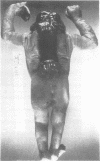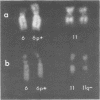Abstract
A familial reciprocal translocation t(6p+;11q−) is presented, unbalanced (6p+) in the craniorachischisic propositus and balanced in his phenotypically normal father, associated with relative infertility, multiple spontaneous abortions, and failure to produce normal offspring. The karyotype-phenotype relationship is discussed with reference to other published cases of partial trisomy for the distal portion of the long arm of chromosome 11, and the concept of deletionunmasking is briefly considered. The occurrence of major neural groove closure defects due to a variety of translocations in mice is noted. The gametic segregation of balanced and unbalanced karyotypes is unique to each particular translocation making recurrence risk projections hazardous in the absence of prior experience with the particular translocation. The questions of the relative importance of genetic inheritance, chromosomal abnormalities, and many environmental factors including possible specific teratogens in causing neural groove closure anomalies are still unsettled. The paucity of published chromosome studies in these malformations is noted. We urge that cytogenetic studies with banding techniques be undertaken on these cases and their parents in order to expand basic knowledge of the role of chromosomal errors in their aetiology.
Full text
PDF






Images in this article
Selected References
These references are in PubMed. This may not be the complete list of references from this article.
- Arias-Bernal L., Jones H. W., Jr An anencephalic male with xx sex chromosome complement. Am J Obstet Gynecol. 1967 Nov 15;99(6):877–878. doi: 10.1016/0002-9378(67)90403-6. [DOI] [PubMed] [Google Scholar]
- Breg W. R. Quinacrine fluorescence for identifying metaphase chromosomes, with special reference to photomicrography. Stain Technol. 1972 Mar;47(2):87–93. doi: 10.3109/10520297209116456. [DOI] [PubMed] [Google Scholar]
- Caspersson T., Lindsten J., Zech L., Buckton K. E., Price W. H. Four patients with trisomy 8 identified by the fluorescence and Giemsa banding techniques. J Med Genet. 1972 Mar;9(1):1–7. doi: 10.1136/jmg.9.1.1. [DOI] [PMC free article] [PubMed] [Google Scholar]
- Christakos A. C., Simpson J. L. Anencephaly in three siblings. Obstet Gynecol. 1969 Feb;33(2):267–270. [PubMed] [Google Scholar]
- DE GROUCHY J., BRISSAUD H. E., REPESSE G., LAMY M. ANENC'EPHALIE FAMILIALE ET REMANIEMENT DE DEUX CHROMOSOMES 13-15. C R Hebd Seances Acad Sci. 1964 Jul 20;259:691–694. [PubMed] [Google Scholar]
- FREZAL J., KELLEY J., GUILLEMOT M. L., LAMY M. ANENECEPHALY IN FRANCE. Am J Hum Genet. 1964 Sep;16:336–350. [PMC free article] [PubMed] [Google Scholar]
- Ford C. E., Clegg H. M. Reciprocal translocations. Br Med Bull. 1969 Jan;25(1):110–114. doi: 10.1093/oxfordjournals.bmb.a070659. [DOI] [PubMed] [Google Scholar]
- Francke U. Quinacrine mustard fluorescence of human chromosomes: characterization of unusual translocations. Am J Hum Genet. 1972 Mar;24(2):189–213. [PMC free article] [PubMed] [Google Scholar]
- GREEN C. R. THE FREQUENCY OF MALDEVELOPMENT IN MAN: THE NEED FOR IMPROVED STATISTICS. Am J Obstet Gynecol. 1964 Dec 1;90:SUPPL–SUPPL1013. doi: 10.1016/0002-9378(64)90831-2. [DOI] [PubMed] [Google Scholar]
- HORNE H. W., Jr Anencephaly in four consecutive pregnancies; report of a case. Fertil Steril. 1958 Jan-Feb;9(1):67–68. doi: 10.1016/s0015-0282(16)32948-x. [DOI] [PubMed] [Google Scholar]
- Jacobs P. A., Aitken J., Frackiewicz A., Law P., Newton M. S., Smith P. G. The inheritance of translocations in man: data from families ascertained through a balanced heterozygote. Ann Hum Genet. 1970 Oct;34(2):119–136. doi: 10.1111/j.1469-1809.1970.tb00226.x. [DOI] [PubMed] [Google Scholar]
- Miller D. A., Allderdice P. W., Kouri R. E., Dev V. G., Grewal M. S., Miller O. J., Hutton J. J. Quinacrine fluorescent chromosome analysis of the Snell translocation in the mouse. Genetics. 1972 Aug;71(4):633–637. doi: 10.1093/genetics/71.4.633. [DOI] [PMC free article] [PubMed] [Google Scholar]
- PENROSE L. S. Genetics of anencephaly. J Ment Defic Res. 1957 Jul;1(1):4–15. doi: 10.1111/j.1365-2788.1957.tb00276.x. [DOI] [PubMed] [Google Scholar]
- Poswillo D. E., Sopher D., Mitchell S. Experimental induction of foetal malformation with "blighted" potato: a preliminary report. Nature. 1972 Oct 20;239(5373):462–464. doi: 10.1038/239462a0. [DOI] [PubMed] [Google Scholar]
- Renwick J. H. Hypothesis: anencephaly and spina bifida are usually preventable by avoidance of a specific but unidentified substance present in certain potato tubers. Br J Prev Soc Med. 1972 May;26(2):67–88. doi: 10.1136/jech.26.2.67. [DOI] [PMC free article] [PubMed] [Google Scholar]
- Riccardi V. M., Atkins L., Holmes L. B. Absent patellae, mild mental retardation, skeletal and genitourinary anomalies, and C group autosomal mosaicism. J Pediatr. 1970 Oct;77(4):664–672. doi: 10.1016/s0022-3476(70)80210-4. [DOI] [PubMed] [Google Scholar]
- Rott H. D., Schwanitz G., Grosse K. P., Alexandrow G. C 11-D 13-translocation in four generations. Humangenetik. 1972;14(4):300–305. doi: 10.1007/BF00290171. [DOI] [PubMed] [Google Scholar]
- Spellman M. P. Chromosome investigations of anencephaly and other congenital C.N.S. abnormalities in cork. Ir J Med Sci. 1966 Sep;6(489):393–398. doi: 10.1007/BF02962415. [DOI] [PubMed] [Google Scholar]
- WARKANY J., RUBINSTEIN J. H., SOUKUP S. W., CU RLESS M. C. Mental retardation, absence of patellae, other malformations with chromosomal mosiacism. J Pediatr. 1962 Dec;61:803–812. doi: 10.1016/s0022-3476(62)80191-7. [DOI] [PubMed] [Google Scholar]






